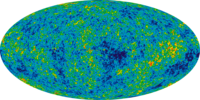
Photo from wikipedia
Strong lensing by galaxy clusters can be used to significantly expand the survey reach, thus allowing observation of magnified high-redshift supernovae that otherwise would remain undetected. Strong lensing can also… Click to show full abstract
Strong lensing by galaxy clusters can be used to significantly expand the survey reach, thus allowing observation of magnified high-redshift supernovae that otherwise would remain undetected. Strong lensing can also provide multiple images of the galaxies that lie behind the clusters. Detection of strongly lensed Type Ia supernovae (SNe Ia) is especially useful because of their standardizable brightness, as they can be used to improve either cluster lensing models or independent measurements of cosmological parameters. The cosmological parameter, the Hubble constant, is of particular interest given the discrepancy regarding its value from measurements with different approaches. Here, we explore the feasibility of the Vera C. Rubin Observatory Legacy Survey of Space and Time (LSST) of detecting strongly lensed SNe in the field of five galaxy clusters (Abell 1689 and Hubble Frontier Fields clusters) that have well-studied lensing models. Considering the 88 systems composed of 268 individual multiple images in the five cluster fields, we find that the LSST will be sensitive to SNe~Ia (SNe~IIP) exploding in 41 (23) galaxy images. The range of redshift of these galaxies is between $1.01 < z < 3.05$. During its 10 years of operation, LSST is expected to detect $0.2\pm0.1$ SN~Ia and $0.9\pm0.3$ core collapse SNe. However, as LSST will observe many more massive galaxy clusters, it is likely that the expectations are higher. We stress the importance of having an additional observing program for photometric and spectroscopic follow-up of the strongly lensed SNe detected by LSST.
Journal Title: Symmetry
Year Published: 2020
Link to full text (if available)
Share on Social Media: Sign Up to like & get
recommendations!